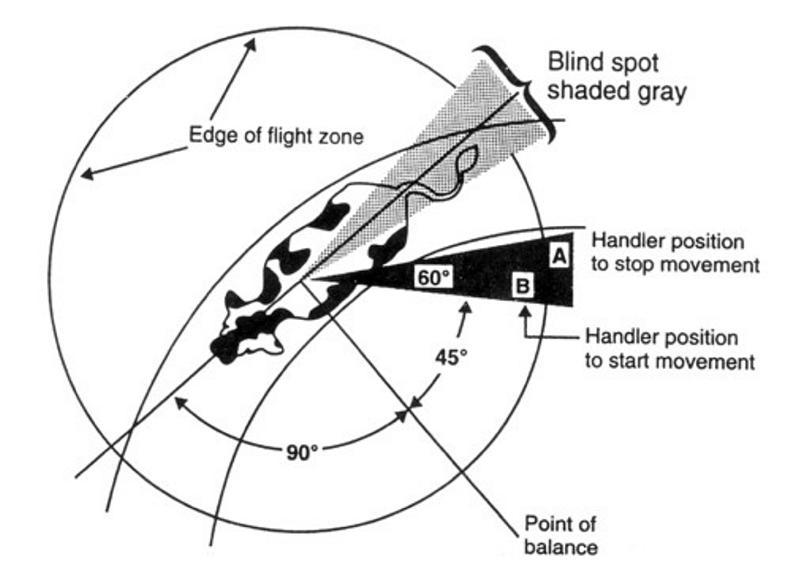Flight zone
The point of balance and flight zone are central to how cattle will react to a herdsman or woman. The concepts were developed by world-renowned animal specialist in the US, Temple Grandin.
The flight zone is a circle around the animal that affects if the animal will move or not. If you are outside the flight zone, the animal will not move but if you move into the flight zone then the animal will begin to move.
It is also key to remember that an animal has a blind spot to the back of them as shown in the diagram.
If we move into the animal’s blind spot they will stop as they cannot see us. This can confuse an animal and make them concerned or agitated, placing the handler in danger. The size of the flight zone depends on how quiet or tame an animal is.
Enter the flight zone
An animal will begin to move away when you enter their flight zone. In a field, you can find the flight zone of an animal by approaching them.
At the edge of the flight zone they will stop eating and raise their head. Once they start to move, you are in the flight zone.

In a field at the edge of the flight zone cattle will stop eating and raise their heads.
Entering the flight zone quickly can prompt fear, aggression or agitation from the animal towards the handler.
The size of the flight zone of an animal will generally get smaller with frequent handling. If in a field all the animals are facing the handler then they are in the flight zone.
When an animal gets excited the flight zone will get bigger. The flight zone also gets bigger when you approach it head on. When cattle are very tame, they will have no flight zone.
These animals can generally be moved by leading.
Point of balance
The point of balance is usually at the animal’s shoulder and is determined as the wide animal’s vision.
When you stand at an animal’s shoulder, it is likely that it will not move. Animals will generally move in the opposite direction that the handler is moving in as they pass by the animal’s point of balance, ie their shoulder.
If a handler stands behind an animal’s point of balance the animal will generally move forward. Many handlers will make the mistake of standing in front of the point of balance while trying to get an animal to move in a chute.
As shown in the diagram, the point of balance can be used to move cattle up a crush.

All species of livestock should move forward if the handler stands behind their point of balance. (Image:Temple Grandin)
The handler first steps into the flight zone and walks quickly in the opposite direction of the animal to make the animal move forward.
When trying to move groups of livestock gently moving into the flight zone can help to get cattle moving.
Once cattle start moving, there is no need to apply constant pressure to the animal’s flight zone. Moving in and out of the flight zone will help to keep animals moving.
Once you get cattle moving, walking in the opposite direction to the cattle will generally speed up movement while walking in the same direction as the cattle will slow down their movement.
Keep cattle calm
Animals have a tendency to want to go back to where they came from, so this should be a big factor in designing facilities.
This is why there are many U-shaped handling units in factories, for example. Do not chase lone animals or stragglers as the motion of the herd should attract them back.
Calm cattle are much easier to move. If cattle get excited, then it can take 20 to 30 minutes for them to calm down again.
People should be quiet when handling cattle as they can find yelling or loud, high-pitched noises very stressful.






 This is a subscriber-only article
This is a subscriber-only article















SHARING OPTIONS: